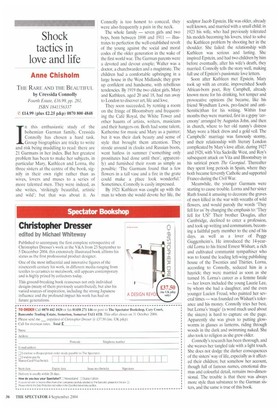Shock tactics in love and life
Anne Chisholm
THE RARE AND THE BEAUTIFUL by Cressida Connolly Fourth Estate, £16.99, pp. 281, ISBN 1841156337 £14.99 (plus 12.25 p&p) 0870 800 4848
In this enthusiastic study of the bohemian Garman family, Cressida Connolly has chosen a hard task. Group biographies are tricky to write and risk being muddling to read: there are 21 Garmans in her index. But her greatest problem has been to make her subjects, in particular Mary, Kathleen and Lorna, the three sisters at the centre of the book, signify in their own right rather than as wives, lovers and muses to a series of more talented men. They were indeed, as she writes, 'strikingly beautiful, artistic and wild'; but that was about it. As
Connolly is too honest to conceal, they were also frequently a pain in the neck.
The whole family — seven girls and two boys, born between 1898 and 1911 — illustrates to perfection the well-established revolt of the young against the social and moral codes of the older generation in the wake of the first world war. The Garman parents were a devoted and devout couple; Walter was a doctor, a churchwarden and a magistrate. The children had a comfortable upbringing in a large house in the West Midlands; they grew up confident and handsome, with rebellious tendencies. By 1919 the two eldest girls, Maly and Kathleen, aged 20 and 18, had run away to London to discover art, life and love.
They soon succeeded, by renting a room on the fringe of Bloomsbury and frequenting the Café Royal, the White Tower and other haunts of artists, writers, musicians and their hangers-on. Both had some talent, Katherine for music and Mary as a painter; but it was their dark beauty and sense of style that brought them attention. They strode around in cloaks and Russian boots, went hatless in summer (something only prostitutes had done until then', apparently) and furnished their room as simply as possible: 'The Garmans found that a few flowers in a tall vase and a fire in the grate could make a place look wonderful.' Sometimes, Connolly is easily impressed.
By 1921 Kathleen was caught up with the man to whom she would devote her life, the sculptor Jacob Epstein. He was older, already well known, and married with a small child; in 1923 his wife, who had previously tolerated his models becoming his lovers, tried to solve the Kathleen problem by shooting her in the shoulder. She failed: the relationship with Kathleen was serious and lasting. She inspired Epstein, and had two children by him before eventually, after his wife's death, they married. Connolly tells the story well, making full use of Epstein's passionate love letters.
Soon after Kathleen met Epstein, Mary took up with an erratic, impoverished South African-born poet, Roy Campbell, already known more for his drinking, hot temper and provocative opinions (he became, like his friend Wyndham Lewis, pro-fascist and anti Semitic)than for his writing. Within four months they were married, first in a gypsy 'cer emony' arranged by Augustus John, and then in church, where to her old nanny's distress Mary wore a black dress and a gold veil. The Campbells' marriage was famously stormy, and their relationship with literary London complicated by Mary's love affair, during 1927 and 1928, with Vita Sackville West, and Roy's subsequent attack on Vita and Bloomsbury in his satirical poem The Georgiad. Thereafter they spent long periods in Spain, where they both became fervently Catholic and supported Franco during the Civil War.
Meanwhile, the younger Garmans were starting to cause trouble. Lorna and her sister Ruth found it amusing to decorate the graves of men killed in the war with wreaths of wild flowers, and would parody the words 'They fell for us' by changing the emphasis to: 'They fell for US!' Their brother Douglas, after Cambridge, declined to enter a profession, and took up writing and communism, becom ing a faithful party member to the end of his days, as well as a lover of Peggy Guggenheim's. He introduced the 14-year old Lorna to his friend Ernest Wishart, a rich and cultivated communist sympathiser who was to found the leading left-wing publishing house of the Twenties and Thirties. Lorna, according to Connolly, seduced him in a hayrick; they were married as soon as she turned 16. Loma's career as a femme fatale — her lovers included the young Laurie Lee, by whom she had a daughter, and the even younger Lucien Freud, who painted her several times — was founded on Wishart's toler ance and his money. Connolly tries her best, but Lorna's 'magic' (a word much used about the sisters) is hard to capture on the page.
Apparently she was given to putting glowworms in glasses as lanterns, riding through woods in the dark and swimming naked. She also took to religion as she grew older.
Connolly's research has been thorough, and she weaves her tangled tale with a light touch.
She does not dodge the darker consequences of the sisters' way of life, especially as it affected their children; but somehow her account, though full of famous names, emotional dramas and colourful detail, remains two-dimensional. The trouble is that there was always more style than substance to the Garman sisters, and the same is true of this book.


































































 Previous page
Previous page